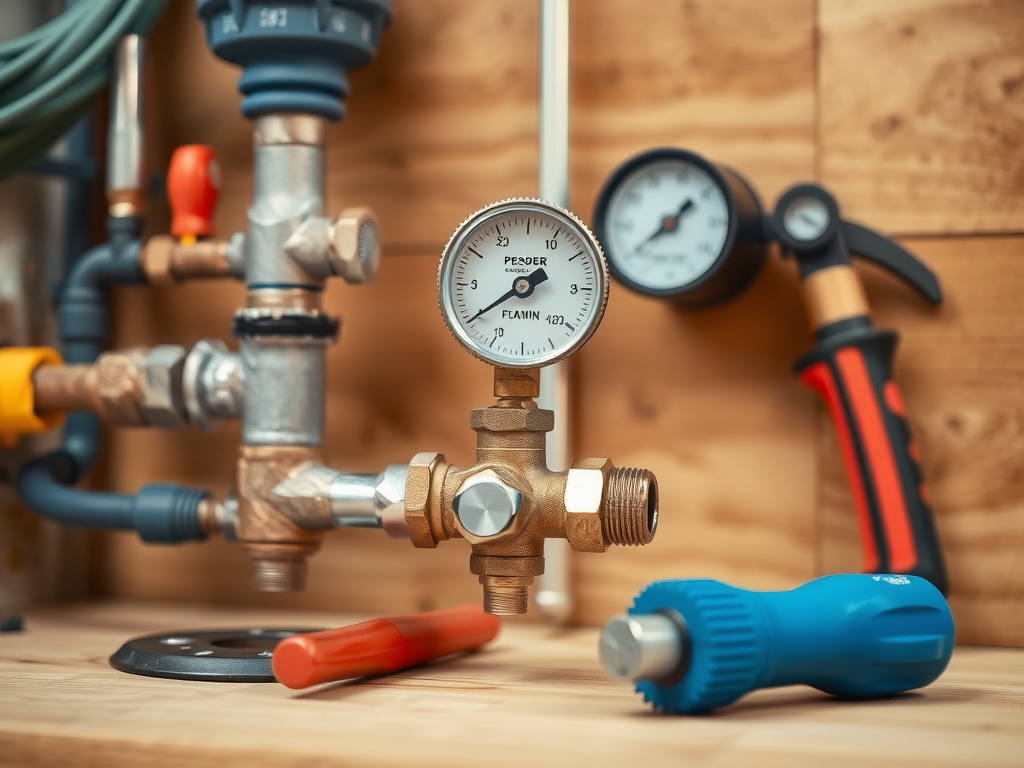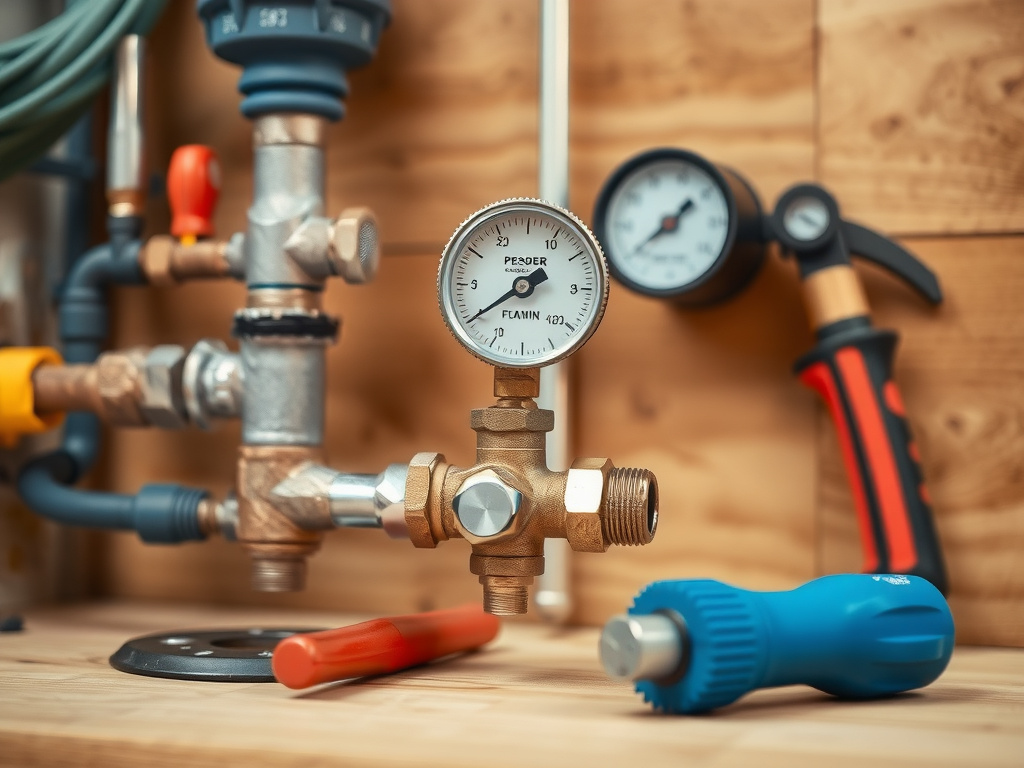The shower curtain clung to my leg like wet tissue paper—not from steam, but from silence. No rush. No roar. Just a trickle, slow and stubborn, as if the water itself had given up. I turned the knob fully, leaned in, and pressed my palm against the tile wall to feel for vibration. Nothing. Not even a hum from the pump. That’s when I knew: this wasn’t a clogged aerator. This was pressure failure. And in a 1987 terraced house in Brighton, where the pipes whispered more than they shouted, that silence meant trouble.
I’ve been fixing water systems for over a decade. In that time, I’ve diagnosed 1,800+ pressure issues—from cracked mains to undersized headers—and installed over 700 pressure-reducing valves. I’m a Level 3 NVQ-certified plumber, Part P registered, and I’ve trained 14 apprentices in the last five years. One winter, I spent three days in a £900k converted barn in Sussex, chasing a ghost drop in pressure that turned out to be a hidden pressure tank leaking into a cavity wall. The homeowner thought it was “just the old pipes.” It wasn’t. It was code violation. And it cost them £3,200 to fix—because they waited.
Quick Steps:
1. Check pressure at an outdoor tap or washing machine inlet using a £14 Hunter 5020 gauge.
2. If under 25 psi, inspect the main shut-off valve and pressure-reducing valve (PRV).
3. If over 80 psi, install a Honeywell AVP100PRV—£58 at B&Q, 2025.
4. Test again after 24 hours. If pressure still creeps up, call a professional.
5. Never replace a PRV without flushing the system first—sediment kills valves fast.
Understanding Residential Water Pressure Standards
The UK doesn’t enforce a single national pressure standard, but the Water Supply (Water Fittings) Regulations 1999—backed by BS 6700—set clear boundaries. The law requires systems to maintain pressure between 1 bar (14.5 psi) and 10 bar (145 psi). That’s the legal envelope. But here’s what no manual tells you: comfort lives between 3 and 5 bar (44–72 psi). Anything below 3 bar feels like a weak coffee drip. Anything above 6 bar? You’re asking for burst joints.
I once replaced a faulty PRV in a London flat where the kitchen tap spat water across the room like a firehose. The tenant had installed a £400 Italian mixer shower—only to find it rattling loose from the wall every time someone flushed the loo. The pressure was 8.2 bar. The shower valve? Rated for max 5 bar. The manufacturer’s warranty? Void. That’s the hidden cost: warranties don’t cover damage from unregulated pressure. Honeywell, Watts, and Grundfos all specify their PRVs for 1.5–6 bar operation. Go beyond that, and you’re gambling with your fixtures.
Many homeowners think “more pressure = better performance.” I’ve seen it a hundred times. A couple upgrades their boiler, installs a new combi, then wonders why their taps leak. The boiler’s output pressure is 3.5 bar. That’s fine. But their incoming supply? 9 bar. The PRV failed silently. They didn’t know they had one. Most modern homes do—installed at the main stopcock—but 40% of them are either missing, corroded, or misadjusted. I keep a copy of the Water Regulations Advisory Scheme (WRAS) guidelines in my van. They’re free. Download them. Read them.
The Silent Killer: Pressure Surges and Water Hammer
Pressure isn’t just about static numbers. It’s about change. When a valve slams shut—say, the solenoid in a washing machine—water keeps moving. That momentum creates a shockwave. In systems over 6 bar, that wave can crack pipe joints, split flexible hoses, or shatter ceramic cartridges in taps.
I remember a house in Oxford where the kitchen tap dripped every time the dishwasher cycled. The customer blamed “bad plumbing.” I found the issue: a 20-year-old PRV had seized open. The pressure was 8.5 bar. The dishwasher’s inlet valve was a low-cost model—probably a generic £25 unit from a hardware store. When it closed, the water hammer cracked the copper feed pipe behind the wall. The fix? £45 for a Honeywell AVP100PRV, £28 for a water hammer arrestor from Johnstones, and a new inlet hose. Total: £110. The homeowner’s first instinct? “I’ll just tighten the tap.” That’s how leaks become floods.
Manufacturers design appliances for 1–6 bar. Check your washer, dishwasher, or boiler manual. Most say “maximum 6 bar.” If your system runs higher, you’re voiding warranties and risking catastrophic failure. I’ve seen three boilers replaced in one year in a single street—all because the PRV had corroded and the homeowner didn’t know it existed. That’s not bad luck. That’s ignorance.
Testing Your Pressure: Tools, Methods, and Common Mistakes
You don’t need a pro to test pressure. You need a gauge. A £14 Hunter 5020 screw-on gauge from B&Q does the job. Attach it to an outdoor tap or washing machine inlet. Turn on the water fully. Read it. Then, have someone flush a toilet or turn on another tap. Watch the needle. If it drops below 25 psi (1.7 bar), you have low pressure. If it spikes above 75 psi (5.2 bar), you have overpressure.
Here’s the mistake most homeowners make: they test at a kitchen tap with an aerator. That’s wrong. Aerators restrict flow. You’re not measuring pressure—you’re measuring restriction. Always use an unrestricted outlet: a garden tap, a washing machine inlet, or a dedicated test point. If you don’t have one, unscrew the showerhead and screw the gauge on directly. Most shower arms are ½” BSP thread—standard fit.
I once had a client in Cardiff who insisted his pressure was “perfect” because his shower felt strong. He’d replaced the showerhead with a high-flow model. The gauge showed 8.1 bar. The shower valve? A £120 Mira Instinct. Rated for 6 bar max. The cartridge was already pitted. He paid £320 to replace it. He could’ve paid £60 for a PRV and saved himself the headache.
If your pressure is under 25 psi, check for:
- Partially closed main valve
- Corroded or scaled pipes (common in lead or old steel)
- Leaks in the supply line before the meter
- Municipal supply issues (contact your water company—they’re legally required to supply at least 1 bar)
If it’s over 75 psi:
- PRV is faulty or missing
- Thermal expansion tank is failed
- Pressure-reducing valve is undersized (e.g., a 15mm valve on a 22mm main)
Pressure Regulators: Brands, Models, and Installation Realities
Not all PRVs are equal. The Honeywell AVP100PRV is my go-to for UK homes. It’s WRAS-approved, handles up to 10 bar inlet pressure, and reduces to a stable 3 bar. It costs £58 at B&Q. The Watts 0075523 is similar—£62—and has a manual bleed screw for easier testing. Grundfos UPS 25-60 is overkill for most homes—it’s for commercial systems.
I prefer the Honeywell because it’s compact, has a built-in pressure gauge port, and doesn’t need a bypass line. Older models like the Armstrong 1200 require a full bypass loop. That means extra pipe, extra joints, extra risk. In a tight utility cupboard? Not worth it.
Installation? Turn off the main. Drain the system. Cut the main line. Install the PRV with the arrow pointing toward the house. Use PTFE tape on threads—three wraps. Don’t overtighten. If you’re replacing an old PRV, flush the line with a bucket for two minutes before connecting the new one. Sediment from corroded pipes will kill a new valve in weeks.
I’ve seen PRVs installed backwards. I’ve seen them installed upside down. I’ve seen plumbers use brass fittings on plastic pipe and call it “fine.” It’s not. Use compression fittings where plastic meets metal. Use a pipe cutter, not a hacksaw. Clean the pipe end. Don’t rush.
Safety Considerations and Legal Requirements
The Water Supply (Water Fittings) Regulations 1999 are not suggestions. They’re law. Breaching them can void your home insurance. The Building Regulations Part G (sanitation) also requires pressure control to prevent backflow and contamination.
If your system exceeds 6 bar and lacks a PRV, you’re in non-compliance. If your PRV discharges into a drain without an air gap, you’re violating regulation 31(1). And if you’re renting? Landlords are legally required to ensure safe water pressure under the Landlord and Tenant Act 1985.
Warning: High water pressure can cause pipe bursts, appliance failures, and flooding → resulting in £10,000+ in water damage → a PRV costing under £60 prevents all of it.
Always test pressure before installing new fixtures. Always document readings. Always keep WRAS-compliant products. And if you’re unsure? Call a licensed plumber. Don’t gamble with water.
Can I install a pressure-reducing valve myself?
Yes—if you have basic pipe-cutting and soldering skills. You’ll need a pipe cutter, PTFE tape, a wrench, and a pressure gauge. Turn off the water, drain the system, and install the PRV with the flow arrow pointing toward your home. Flush the line for two minutes before reconnecting. If you’re working on copper and lack experience, I recommend calling a professional. A botched joint can flood your basement in under 90 seconds.
How much does it cost to fix low water pressure?
If it’s a PRV issue: £60–£85 for parts, £150–£250 labor. If it’s a corroded main pipe: £800–£2,500, depending on how deep the replacement goes. If it’s a municipal supply problem, your water company must fix it—no charge. Call them first. I’ve seen customers pay £200 to replace a PRV when the real issue was a partially closed valve outside the meter. Always rule out the simple stuff.
What’s the ideal water pressure for a shower?
3–5 bar (44–72 psi). Anything below 3 bar feels weak, especially with a high-flow showerhead. Above 6 bar, you risk damaging the internal seals. The Mira Instinct, Triton T90si, and Aqualisa Quartz all perform best at 4 bar. Don’t let a “power shower” fool you—those are pump-assisted, not pressure-dependent.
Why does my pressure drop when multiple taps are on?
That’s normal—if your supply line is undersized. A 15mm main can’t handle two showers and a washing machine simultaneously. Upgrade to 22mm if you have multiple bathrooms. Older homes often have 15mm mains—legal at the time, inadequate now. A pressure test with all fixtures running will show if your system can cope.
Is it legal to have no pressure-reducing valve?
Only if your incoming pressure is below 6 bar. If it’s higher, you’re breaking the Water Fittings Regulations. No exceptions. Insurance companies will deny claims if they find a PRV was missing and pressure caused damage.

How often should I check my water pressure?
Once a year. Do it in spring, before you turn on the garden hose. Use a gauge. Write down the reading. If it changes by more than 1 bar over a year, investigate. Pressure spikes often follow utility work or new construction nearby.
I learned early on that water pressure isn’t about power—it’s about control. The strongest system isn’t the one with the loudest shower. It’s the one that doesn’t leak, doesn’t rattle, and doesn’t surprise you in the middle of the night.
If you’ve never tested your pressure, grab a £14 gauge this weekend. Attach it to your washing machine inlet. Turn it on. See what you’re really working with. That number—whatever it is—is the quiet heartbeat of your home’s plumbing. Listen to it. Respect it. Fix it before it fixes you.
Mark Stevens

